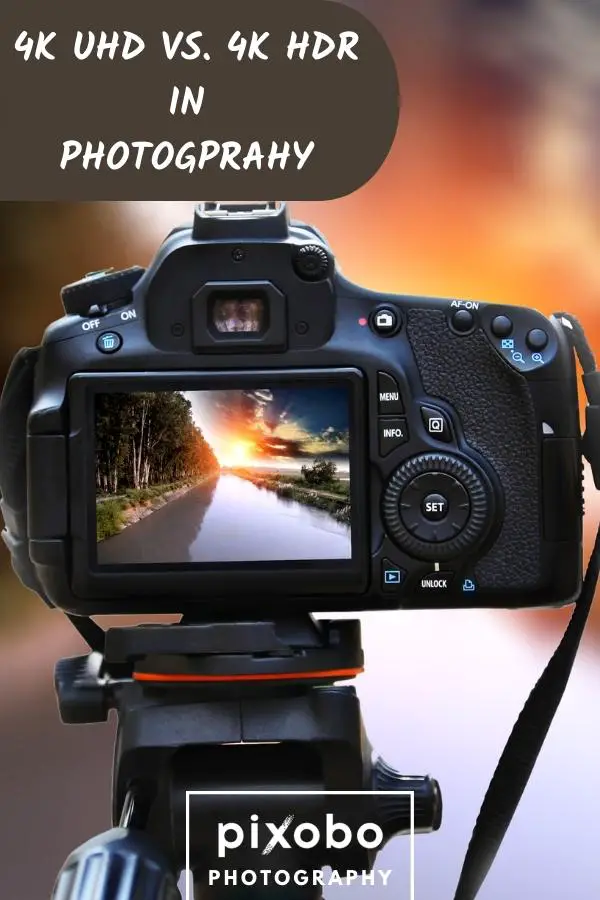If you have bought a TV, you may have heard the terms 4K UHD and 4K HDR and understood clearly what they mean. But if you are new to photography, you might not know what exactly they mean.
Although these two terms may have similar purposes, they are different from each in so many ways, particularly in photography and videography. To start with, UHD and HDR are improvements in image and video quality.
Both of them have attracted many photographers and still do. Camera manufacturers have been continuously improving these two features over the years.
So if you want to understand them better, this article will teach you the difference between 4K UHD and 4K HDR.
Table of Content
What Is 4K UHD?

UHD stands for Ultra High Definition, which represents the resolution of a display. For the display market, an HD display has 1,366 x 768 pixels = 1MP (Mega Pixels).
On the other hand, a Full HD display is 1920 x 1080 pixels = 2MP. Since UHD is 4 times Full HD, it has a resolution of 3840 x 2160 = 8MP. This is why it is also referred to as 4K UHD.
Note, however, that 4K UHD has different standard resolutions depending on the display. The resolution of 4K UHD for TV and digital cameras is 3840 x 2160 pixels. It means that a 4K UHD has twice the number of pixels horizontally compared to Full HD. Hence, a 4K UHD display has 4 times the total pixels and 4,000 horizontal pixels.
Meanwhile, the digital cinema market also has a standard for 2K and 4K resolutions based on the DCI (Digital Cinema Initiatives). Here, 2K has a resolution of 2048 x 1080, while 4K has a resolution of 4096 x 2160.
But no matter what device you are referring to, 4K UHD simply means capturing more details, resulting in crispier and sharper images.
What is a 4K UHD Camera?
4K refers to the resolution of the screen of a TV or a camera. But just to be clear, 4K is the same as UHD, and it is only used in videos, not in photos.
So, if you want to have a 4K photo, take a single frame grab from a 4K video footage. In short, you cannot take a 4K photo without recording a video using your digital camera.
These days, 4K video has become the new standard in cameras. Canon, Nikon, and Panasonic are now selling DSLR and mirrorless cameras that can shoot 4K videos in a wide variety of frame rates.
Some of them also have a feature called 4K Photo mode, where photographers can choose the best still image while shooting a 4K video.
What Is 4K HDR?
HDR stands for High Dynamic Range, a term used in TV screens and digital cameras. Although HDR has the same goal for both devices, it has different techniques.
With HDR technology, the contrast between very dark and very light colors on the screen will have a noticeable improvement. Black will be much darker, and white will be much brighter.
The ratio between the brightest image and the darkest image on TV is called the contrast ratio. An HDR TV has a significantly higher contrast ratio than an SDR (Standard DR) TV and can showcase 1,024 shades of red, green, and blue.
Since 4K refers to resolution, an HDR TV with 4K is called a 4K HDR TV. However, not all 4K TVs can support HDR.
In film and digital photography, HDR is not a popular term but has been around for a long time. In fact, HDR photography was used by French photographer Gustave Le Gray in the 1850s.
At that time, he used two separate monochromatic negative images of water and sky and combined them using a process known as combination printing.
What Is a 4K HDR Camera?
HDR is a technology and is not related to the display resolution whatsoever. But unlike TV, which is a display device, a camera is a capture device.
In short, 4K cameras have a resolution of 3840 x 2160 (8MP), while HDR cameras are those that have an HDR setting. Hence, 4K HDR cameras can shoot 4K videos and can create HDR photos.
In the old days, a high dynamic range was referred to as exposure bracketing. This creative post-processing technique allows photographers to take the same image at multiple exposures.
Today, HDR photos can be created using the software. Note, however, that some cameras have HDR settings on them but don’t have 4K video capabilities.
4K UHD vs. 4K HDR: What Is the Difference?

4K UHD and 4K HDR are very important aspects of TV displays and photography. But although both of them are standards, they are not competing against each other.
4K and UHD also mean the same thing. On the other hand, 4K and HDR don’t belong to the same standard. Below are the differences between 4K UHD vs. 4K HDR in cameras:
- UHD refers to the screen resolution, while UHD refers to a technology associated with contrast ratio.
- UHD is a recently upgraded version of displays, while HDR is almost as old as cameras.
- UHD can only be achieved through video recording, while HDR is only applicable to photos.
- UHD only adds color definition, while HDR greatly affects color reproduction.
- UHD images can be previewed directly on cameras, while HDR images are usually created during post-production.
UHD vs. HDR: Pros and Cons

In photography, 4K photos have higher-quality images compared to photos with a lower resolution. On the other hand, HDR photos may look better than those not used with HDR.
However, it does not necessarily mean that using them is always better. To help you out, here are the advantages and disadvantages of UHD and HDR photos:
Pros of 4K (UHD)
- 4K photos have exceptional image quality.
- Colors are captured even in the smallest detail.
- 4K is optional, which means you use it only if you want to.
- Cleaner images during editing or post-production
- Ideal for professional videographers and photographers
Cons of 4K (UHD)
- 4K cameras are quite expensive
- You may not always need 4K shooting
- Photo editing can be time-consuming
- 4K videos require a higher storage capacity
- 4K videos may lag or cannot be played on some devices
Pros of HDR
- HDR photos have more details in shadows and look more realistic
- Eliminates image noise and ghosting
- Ideal for landscape, portrait, and sunset photography
- Some cameras and smartphones have HDR, which eliminates the need for special post-production software
- HRD setting is optional, which you can turn off if you don’t need it.
Cons of HDR
- HDR photos consume a lot of space
- HRD photos can be blurry if your camera is shaking or if the subject is moving
- Not applicable in all types of photography
- Some HDR cameras cannot capture the entire dynamic range of a scene
- If your camera has no HDR, post-processing can be time consuming
4K UHD vs. 4K HDR: Which One is Better?

As explained above, UHD is about pixel quantity, while HDR is about pixel quality. So, asking if UHD is better than HDR is like asking if Jacky Chan is better than Michael Jordan.
You cannot compare them based on their capabilities and say that one is better than the other. The good news is that you can enjoy both of them with the same camera.
Do You Need a 4K UHD Camera?

If you are a casual photographer, you may not need a 4K camera yet. But if you have the budget, buying one can be an advantage especially if you are planning to be a professional photographer.
Note that you can upload 4K videos on YouTube. But as of posting, Facebook accepts only up to 1080p videos and has some strict requirements.
Do You Need HDR in Camera?
Since HDR is a technology and not a device, it is present in almost all kinds of modern cameras and smartphones. It is also not linked to resolution, which means you can still use it even if your camera offers a resolution of 1920 x 1080 or lower. So, if you are serious about portrait and landscape photography, you need to turn the HDR settings on.
UHD and HDR have brought a great leap in photography. Cameras with higher resolutions provide better-looking and sharper images while cameras that are set on a higher dynamic range can capture higher contrast photos and provide more details that our eyes cannot see. Therefore, you should try using them to enjoy your camera more.

